Advertisements
Advertisements
Question
The length of a hall is 18 m and its width is 13.5 m. Find the least number of square tiles, each of side 25 cm, required to cover the floor of the hall,
(i) without leaving any margin.
(ii) leaving a margin of width 1.5 m all around. In each case, find the cost of the tiles required at the rate of Rs. 6 per tile
Solution
(i)
Length of hall (l) = 18 m and breadth (b) = 13.5 m

∴ Area of the floor = l × b
=`18 xx 13.5 "m"^2 = 243.0 "m"^2`
Side of each square tiles (a) = 25 cm
= `25/100 = 1/4`m
∴ Area of one tile = a2 = `1/4 xx 1/4`
= `1/16 "m"^2`
No. of tiles required = `243 + 1/16`
= `(243 xx 16)/1 = 3888`
Rate of tiles = Rs. 6 per tile
∴ Total cost = Rs. 3888 × 6
= Rs. 23328
(ii)
Width of margin left in side = 1.5 m
∴ Inner length = `18 - 2 xx 1.5 = 18 - 3 = 15` m
and breath = `13.5 - 2 xx 1.5 = 13.5 - 3`
= 10.5 m
∴ Inner area = `15 xx 10.5 "m"^2`
= 157.5 m2
∴ No. of tiles = 157.5 + `1/16`
= `157.5 xx 16 = 2520`
∴ Cost of tiles = 2520 × 6 = Rs. 15120
APPEARS IN
RELATED QUESTIONS
Find the perimeter of a square; whose area is: 1.69 m2
The diagonal of a square is 12 cm long; find its area and length of one side.
The diagonal of a square is 15 m; find the length of its one side and perimeter.
The perimeter of a square is numerically equal to its area. Find its area.
The table given below contains some measures of the square. Find the unknown values.
| Side | Perimeter | Area |
| 6 cm | ? | ? |
A square shaped park ABCD of side 100m has two equal rectangular flower beds each of size 10m × 5m (Figure). Length of the boundary of the remaining park is ______.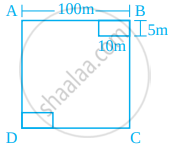
Three squares are joined together as shown in figure. Their sides are 4 cm, 10 cm and 3 cm. Find the perimeter of the figure.
In the given figure, each square is of unit length
(a) What is the perimeter of the rectangle ABCD?
(b) What is the area of the rectangle ABCD?
(c) Divide this rectangle into ten parts of equal area by shading squares. (Two parts of equal area are shown here)
(d) Find the perimeter of each part which you have divided. Are they all equal?
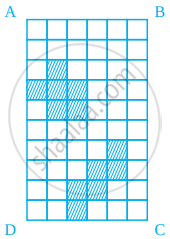
Avneet buys 9 square paving slabs, each with a side of `1/2` m. He lays them in the form of a square.
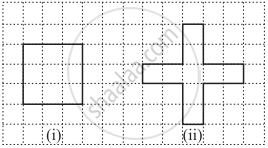
- What is the perimeter of his arrangement [Fig (i)]?
- Shari does not like his arrangement. She gets him to lay them out like a cross. What is the perimeter of her arrangement [(Fig (ii)]?
- Which has greater perimeter?
- Avneet wonders if there is a way of getting an even greater perimeter. Can you find a way of doing this? (The paving slabs must meet along complete edges i.e. they cannot be broken.)
In the given figure, perimeter of (ii) is the same as (i).
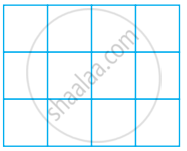 |
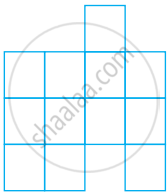 |
| (i) | (ii) |
